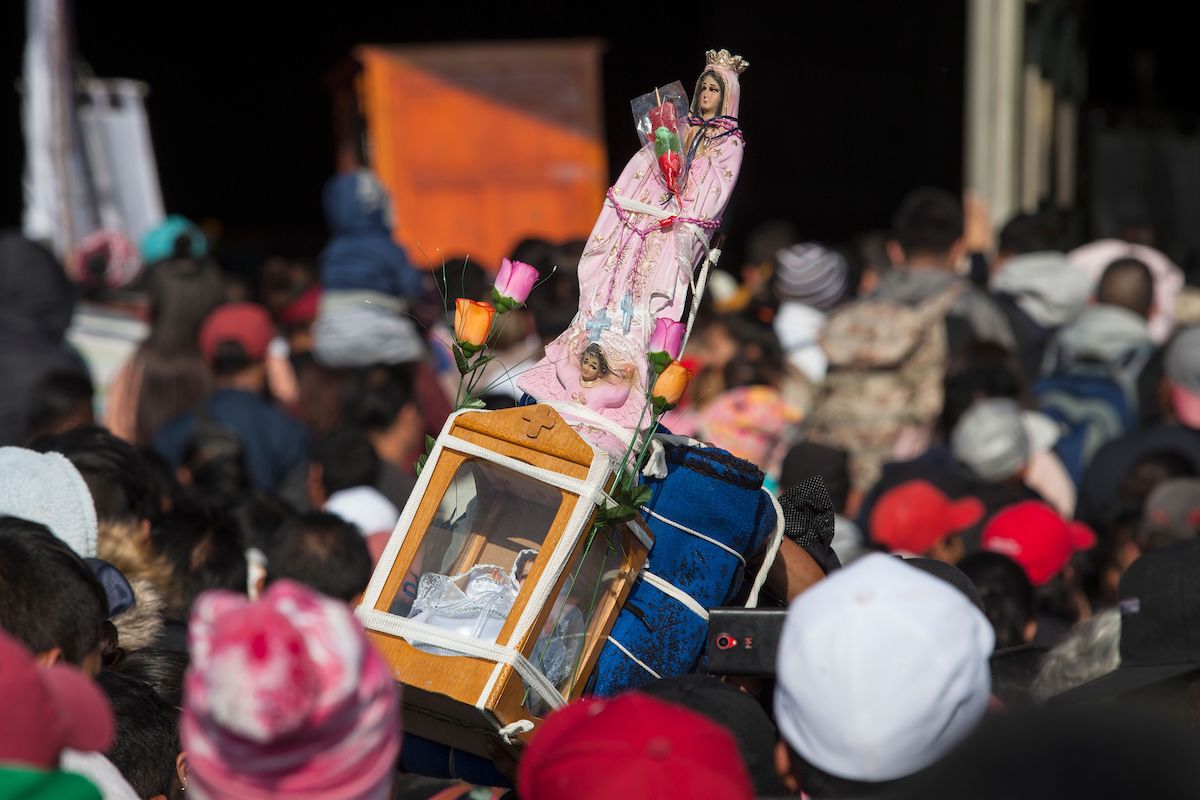

A pilgrim carries a statuette of the Virgin of Guadalupe on his back during the annual celebrations at the Basilica of Guadalupe in Mexico City, on December 12, 2019. (Photo by CLAUDIO CRUZ/AFP via Getty Images)
Two months ago, I was in El Paso, Texas, for a Catholic teach-in. The teach-in was focused on social justice and the topic of immigration. While there are many ways to talk about immigration, this particular conference focused on the Catholic perspective on the topic.
For those who do not know, El Paso is a border town. It borders Juárez, Mexico. This means you can see both Mexico and the border wall from El Paso. The identity of this town is so intertwined with immigration, migration, and walls. In the middle of downtown El Paso, there is a giant bridge that connects the U.S. to Juárez. And this bridge lies in the middle of the border wall that separates the two countries.
On the second day of this conference, we walked across this bridge. We did this so we could meet with families who were seeking asylum. Simply put, asylum is when someone has left their country because it is no longer safe to live, and they attempt to seek refuge in another country in order to survive. The goal was to walk with them as they asked for asylum and to pray with these families as they prepared to do so.
Now as you’re walking across, there are armed guards everywhere—holding these massive guns. There is a huge and intimidating wall next to you, whose unnaturalness is so stark. Below the bridge there are armed vehicles driving back and forth searching for those trying to cross. And you can feel how connected El Paso and Juárez are. When we finished crossing the bridge, the scene to the left was startling.


United States agents of the Customs and Border Protection Office keep the Paso del Norte International Bridge closed on August 16, 2019. (Photo by HERIKA MARTINEZ/AFP via Getty Images)
The street parallel to the wall on the Mexico side of the border was filled with tents and families. We talked with various families. I talked to a mother who was carrying a beautiful 9-month-old baby in her arms. She was wrapped in a white, fuzzy Hello Kitty blanket, and her big cheeks were the only thing sticking out. She told me that her and her family had just walked three weeks to seek asylum.
You could feel the weight of injustice. Here were families, with nothing but blankets and tents that had been provided by Catholic sisters in the U.S. next to this highly militarized border wall. A woman carrying her new child was being welcomed by a border patrol agent with a gun, an unsettling image. So, what is the Catholic response?
Today, December 12, we celebrate the feast of Our Lady of Guadalupe. In Mexico, for Mexican-American families, and for those immigrating to the U.S., La Virgen de Guadalupe is a symbol of hope and safety. La Virgen is usually described as having beautiful brown skin and sun around her. As the story goes, Mary appeared to a poor indigenous man named Juan Diego and asked him to build a church for her. Juan Diego approach the bishop about this, and the bishop did not believe him—he said Juan Diego needed to bring him a sign. La Virgen reappeared to Juan Diego and ordered him to go to a mountain to get roses and put them in a cloak. Juan Diego took these roses to the bishop and when he opened his cloak, dozens of roses fell to the floor AND revealed the image of La Virgen de Guadalupe. The miracle had been proven and the Church was built.
When I think about the mom I met in Juárez, I think about Juan Diego. Both have been asked to do the impossible and neither are met with a warm welcome. Juan Diego is met with a bishop who doubts Mary would choose a poor indigenous man to carry out such an act of faith. And the mother with the young baby is met by a militarized border and often harsh anti-immigrant rhetoric.
But this story shows us that the eyes of God are always looking for those who are most vulnerable. That La Virgin is on the side of Juan Diego and I believe she is also with that mother and child. Because Mary knows what is like to have to seek refuge for her child as a means of safety and she knows what it is like to have people doubt her. But Mary is chosen by God for a reason.


Aerial view of pilgrims gathering outside the Basilica of Guadalupe during the annual celebrations of the Virgin of Guadalupe in Mexico City, on December 12, 2019. (Photo by PAULA VILELLA/AFP via Getty Images)
Being in Boston right now, so far away from the border, one might wonder, how does this apply to me? What is our role as people of faith? And as Catholics?
Well, we have two choices. We can be like the bishop, who looks down on the poor and the vulnerable, and doubts that they have good intentions. OR we can be the disciple who meets someone with a warm welcome. Who says I believe you. Our faith teaches us to do this so vividly, over and over again.
This feast day reminds us to listen who are seeking shelter for their family. It reminds us to welcome the immigrant. But most importantly, it challenges us to believe.
***
Melissa Cedillo is currently pursuing her master’s in theological studies at Harvard Divinity School. She is a former Campaigns Associate at Faith in Public Life in Washington, D.C. and graduated from Loyola Marymount in 2018 with a degree in theological studies. She is passionate about Latinx Faith depictions. Melissa tweets from @melissann19.


